COLIN CLARK

Members of Ukraine’s Territorial Defense Forces pose for photos during their military training on February 27, 2023 near Chernobyl, Ukraine. Russia’s large-scale assault on Ukraine has entered its second year, with the fiercest fighting concentrated in the country’s east and south. (Photo by Roman Pilipey/Getty Images)
LANPAC — The importance of a military’s ability to write algorithms at the edge of battle and then use them effectively, combined with a willingness to change doctrine and tactics to anticipate and destroy enemy forces, may be the biggest lessons of the Ukraine war, a key leader of the US Army’s XVIII Airborne Corps said last week.
The formidable forces of Russia were expected to sweep across Ukraine in a few short weeks. While Ukrainian forces wobbled in the first days of war they quickly began to adapt and use new tactics, techniques and procedures, getting inside the unchanging Russian decision-making process, TJ Holland, Command Sgt. Major of the XVIII Airborne Corps noted at the recent LANPAC conference in Honolulu.
He compared the situation to the start of World War II, where many experts thought France possessed one of the world’s best armies, a force that could stand up to German aggression. But Germany mounted a relatively small number of FM radios on its land vehicles and changed the speed of decision making, allowing the Nazis to overcome French forces in a remarkable six weeks.
“Ukraine’s using data right now as effectively and efficiently as the Germans used FM radio,” Holland said. “And they’re able to mass effects at the most decisive point in time to achieve their operational advantage, because they’re making decisions faster than the Russians can, because the Russians — guess what, like the French — they’re stuck in their way of war. And that’s a really great thing.”
Key to moving men and materiel — massing effects — is the ability to gather and use data. Ukraine, with its innovative use of the commercial Starlink satellite system, coordination with the United States and other NATO allies, is proving to be an innovative user in that regard.
“I can touch any army that’s holding that key piece of terrain from anywhere in the world,” the command sergeant major said. “I can influence them with data, right? I don’t have to be in the same hemisphere.”
Much of that is due to algorithms written by US and allied troops, Holland said. One was written for a commander who wanted to understand counter-battery fire between Russia and Ukraine. “That same algorithm showed us actually, we know the Russian way of war. So now we know if they’re posturing for a counter offensive, or they’re pausing and reinforcing. Or what they’re about to do next, another operation based off counter battery fires,” he said. “And we’ve learned through that and we’ve iterated and we’ve been able to write more code and more algorithms that can only happened when we have, you know, we have great young men and women that wear this uniform that are on the edge and do those great things.”
That kind of data is absolutely vital to resupply for crucial items. Knowing how much ammunition you’ve used, where you can get more and how quickly you can move it. Knowing the best ways to move troops in and out of the front lines as they grow weary. Knowing how many drones you’ve used and where and when you can get more has been especially important for the Ukrainians, who depend on them for reconnaissance and counter-reconnaissance.
“The loss rate for Ukrainian UAVs at the moment is about 10,000 UAVs a month,” Jack Watling, a senior research fellow at the Royal United Services Institute, said at LANPAC. (RUSI is an independent British think tank.)
Watling had only left Ukraine 10 days before the conference. “That’s the level of equipment that both sides are going through. And so when you’re in that environment, that frenetic activity at the front, your people get tired. You know, you have to rotate them out of the line. But every time you rotate them back and you push more people forward, you expose them to fire because they’re now out of the protections provided by their defensive positions.”
Managing all that requires masses of data that must be shared quickly and effectively. The problem isn’t new — consider the vast logistics of World War I when men and mountains of supplies were moved across Europe by trains. But the speed of data introduces new challenges and opportunities, as the Ukrainians have shown.
Key to making that possible through the stress of combat is managing the Electro-Magnetic Spectrum (EMS). This isn’t necessarily about some frequencies being jammed in particular areas, Watling said.
“Where you have real massive friction is the uncertainty that is generated by a catch-all and continuous disruption in the EMS, because then I don’t know whether my orders go through. I don’t know what the latency is going to be between me launching a UAV and the off-boarding of the data from it. Therefore, it’s very difficult to plan, synchronize, coordinate,” he said.
No comments:
Post a Comment